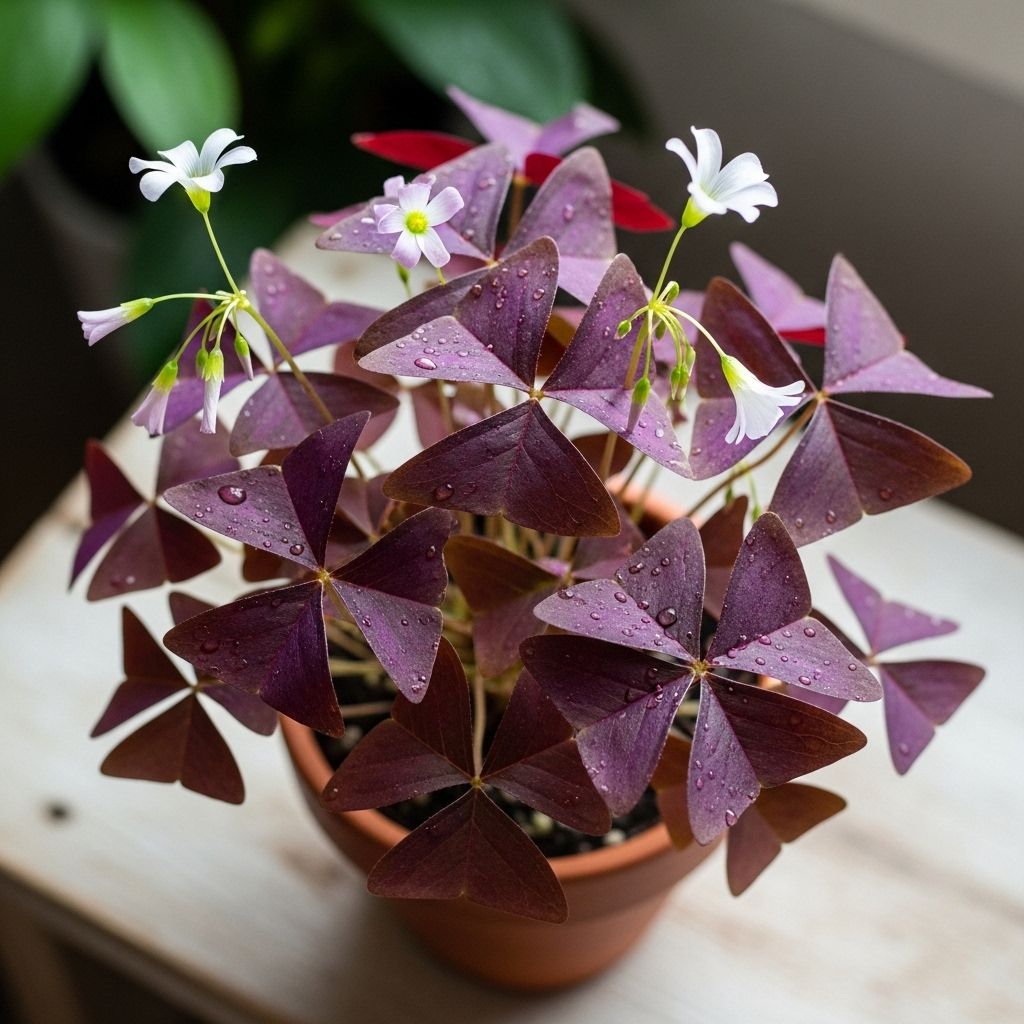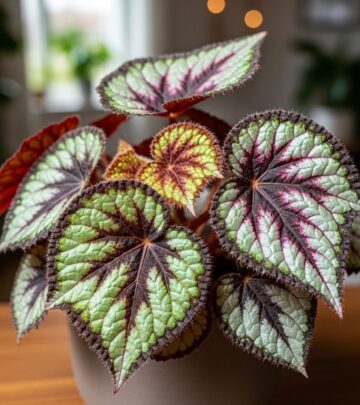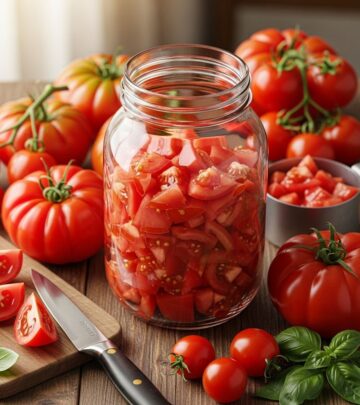Shamrock Plant Care: 4 Essential Tips For Thriving Oxalis
Discover the fascinating world of shamrocks beyond St. Patrick's Day symbolism

Image: HearthJunction Design Team
Understanding Shamrocks: Beyond the Luck of the Irish
When St. Patrick’s Day approaches, the iconic shamrock becomes a ubiquitous symbol of Irish culture and heritage. However, these charming plants offer much more than just festive decoration. Shamrocks have a rich history deeply woven into Celtic tradition and represent one of the most recognizable botanical symbols in the world. Beyond their cultural significance, shamrocks are versatile plants that can enhance gardens, containers, and indoor spaces with their distinctive foliage and delicate blooms.
Whether you’re interested in growing shamrocks for their cultural connections or simply appreciate their aesthetic appeal, understanding these plants’ true nature, varieties, and care requirements will help you successfully incorporate them into your garden or home. This comprehensive guide explores everything from the botanical facts and historical significance to practical growing tips for these beloved plants.
Shamrock vs. Clover: Understanding the Difference
One of the most common misconceptions surrounding shamrocks is their relationship to clovers. While often used interchangeably in casual conversation, shamrocks and clovers are botanically distinct. The true shamrock is traditionally associated with the Oxalis genus, particularly Oxalis acetosella (wood sorrel), while clovers belong to the genus Trifolium.
The defining characteristic of a shamrock is its three leaves—a feature that holds significant symbolism in Irish culture. According to tradition, St. Patrick used the three-leaved shamrock to explain the Christian concept of the Holy Trinity to the Irish people, with each leaf representing the Father, Son, and Holy Spirit. This historical connection cemented the shamrock’s place as a symbol of Irish identity and spirituality.
In contrast to the popular four-leaf clover (Trifolium repens), which is considered a lucky mutation, the true shamrock always has three leaves. While people often search for four-leaf clovers as symbols of good fortune, these are not the traditional shamrocks associated with St. Patrick and Irish heritage.
Popular Varieties of Shamrocks for Gardens and Homes
The Oxalis genus encompasses over 800 species found throughout the world, offering remarkable diversity in appearance and growing requirements. Here are some of the most popular varieties for garden and home cultivation:
Purple Shamrock (Oxalis triangularis)
Also known as false shamrock or love plant, this striking variety features deep purple, triangular leaves that fold up at night or during low light conditions. Small, pale pink or white flowers appear above the foliage during its blooming period. Growing to about 12 inches tall, purple shamrock makes an excellent houseplant or shade garden addition in zones 8-11.
Wood Sorrel (Oxalis acetosella)
This native European species is considered by many to be the “true shamrock” of Ireland. It features delicate, light green leaves and dainty white flowers with pink veining. Growing naturally in woodland settings, wood sorrel thrives in shady, moist conditions and can be grown in zones 4-9.
‘Zinfandel’ Shamrock (Oxalis spiralis subsp. vulcanicola)
This striking variety showcases rich burgundy evergreen foliage that provides a dramatic backdrop for its bright yellow flowers. Native to Central America, ‘Zinfandel’ shamrock grows about one foot tall and prefers well-drained soil and partial shade conditions. It’s suitable for zones 9-11 and works beautifully in containers.
Iron Cross Shamrock (Oxalis tetraphylla)
Named for the distinctive dark pattern at the center of its four green leaflets (yes, this oxalis naturally has four leaves!), the iron cross shamrock produces bright pink to red flowers. This variety grows from small bulbs and can reach 6-12 inches in height, performing well in zones 8-11.
Growing Shamrocks: Care and Cultivation Tips
One of the most appealing aspects of shamrocks is their relatively straightforward care requirements, making them accessible to gardeners of all experience levels. Whether grown as houseplants, in containers, or directly in garden beds, shamrocks can thrive with proper attention to their basic needs.
Light Requirements
Most shamrock varieties prefer bright, indirect light when grown indoors. Direct sunlight can scorch their delicate foliage, while too little light may result in leggy growth. In outdoor settings, shamrocks generally perform best in partial shade, especially in warmer climates where afternoon protection from intense sun is beneficial.
Soil and Water Needs
Well-draining soil is crucial for shamrock health. For container cultivation, use a quality potting mix enhanced with approximately one-quarter sand to improve drainage. For garden planting, incorporate organic matter into heavier soils to prevent waterlogging.
Water shamrocks moderately, allowing the soil to dry slightly between waterings. Overwatering is a common cause of failure with these plants, often leading to bulb rot. During their dormant period, reduce watering significantly to match their natural cycle.
Temperature and Humidity
Most shamrock varieties prefer moderate temperatures between 60-75°F (15-24°C). They typically don’t tolerate extreme heat or cold well, which is why they’re often grown as houseplants in regions with harsh winters. Average household humidity is generally sufficient, though they appreciate occasional misting in very dry environments.
Understanding Dormancy
An important aspect of shamrock care is recognizing their natural dormancy cycle. Depending on the variety and growing conditions, shamrocks may enter a rest period during which their foliage dies back. This is normal and not a sign of plant failure. During dormancy:
- Reduce watering significantly
- Avoid fertilizing
- Keep the plant in a cool location
- Wait patiently for new growth to emerge
Shamrocks in Garden Design and Landscaping
Beyond their cultural significance, shamrocks offer versatile design applications in both indoor and outdoor spaces. Their distinctive foliage provides texture and color that complements many garden styles.
Container Plantings
Shamrocks excel in container gardens, where their spreading habit can cascade over edges or fill in around taller specimens. Consider these container applications:
- St. Patrick’s Day themed pots with green oxalis varieties
- Mixed shade containers where purple shamrocks provide color contrast
- Indoor dish gardens or terrariums featuring miniature shamrock varieties
- Hanging baskets that showcase the trailing growth of certain varieties
Landscape Uses
In suitable climates, shamrocks can serve as charming additions to the landscape:
- Groundcover in shaded woodland gardens
- Accent plants along pathways or garden borders
- Fillers between stepping stones or in rock gardens
- Seasonal color in partially shaded beds
Shamrock Cultural Significance and Traditions
The shamrock’s cultural importance extends far beyond its botanical characteristics. As Ireland’s national emblem, it carries rich symbolism and has become an internationally recognized symbol of Irish heritage.
The tradition of wearing shamrocks on St. Patrick’s Day, known as “the wearing of the green,” dates back centuries in Ireland. Originally a religious symbol explaining the Trinity, the shamrock later became a symbol of Irish nationalism and rebellion against British rule. Today, it represents Irish identity worldwide and is incorporated into everything from sports team logos to corporate branding.
Beyond Irish traditions, the shamrock’s three leaves have symbolized different trinities in various cultures, including mind-body-spirit in new age spirituality and hope-faith-love in some Christian interpretations. This multi-layered symbolism has contributed to the shamrock’s enduring popularity across cultural boundaries.
Common Problems and Troubleshooting
While shamrocks are generally easy to grow, they can encounter several common issues. Understanding these potential problems and their solutions will help ensure your plants remain healthy and vibrant.
Leggy Growth
Insufficient light often causes shamrocks to develop long, weak stems as they stretch toward light sources. Move the plant to a brighter location (while still avoiding direct, harsh sunlight) and consider rotating it regularly to encourage even growth.
Pest Issues
Spider mites, aphids, and mealybugs occasionally affect shamrocks, particularly when grown indoors. Treat infestations early with insecticidal soap or neem oil, being careful to cover all plant surfaces, including leaf undersides.
Yellowing Leaves
Yellowing foliage can indicate several problems, including overwatering, poor drainage, or natural dormancy. Check soil moisture levels first—if the soil feels consistently wet, reduce watering frequency and ensure proper drainage. If yellowing appears seasonal and affects the entire plant, it may simply be entering its dormant phase.
Frequently Asked Questions About Shamrocks
Q: Are shamrocks and four-leaf clovers the same plant?
A: No, they are not the same. True shamrocks (typically Oxalis species) have three leaves, while four-leaf clovers are mutations of Trifolium species (true clovers) that normally have three leaves. The four-leaf clover is considered lucky because of its rarity, while the shamrock’s significance comes from its association with St. Patrick and Irish heritage.
Q: Are shamrocks difficult to grow indoors?
A: Shamrocks are generally easy to grow indoors if given the right conditions. They prefer bright, indirect light, moderate watering (allowing the soil to dry slightly between waterings), and average room temperatures. The biggest challenge is often recognizing and properly handling their dormancy period, during which foliage may die back completely.
Q: Can shamrocks be invasive in the garden?
A: Some Oxalis species can become invasive in certain climates. Species like Oxalis pes-caprae (Bermuda buttercup) are considered aggressive in mild climates. Research your specific variety and consider growing potentially invasive types in containers rather than directly in garden beds.
Q: Why do shamrock leaves fold up at night?
A: The folding of shamrock leaves, known as nyctinasty, is a natural response to changes in light. This movement helps protect the plant by reducing water loss at night and potentially deterring nocturnal feeders. The leaves will reopen when daylight returns.
Q: Are shamrocks edible?
A: Some Oxalis species are edible in small quantities, with a pleasant sour taste due to their oxalic acid content. However, they should be consumed in moderation as oxalic acid can interfere with nutrient absorption and may cause problems for people with certain health conditions. Never consume any plant unless you are absolutely certain of its identity and edibility.
Whether you’re drawn to shamrocks for their cultural significance, their ornamental value, or simply as a nod to Irish heritage around St. Patrick’s Day, these versatile plants offer beauty and interest that extends far beyond their symbolic importance. With proper care and attention to their unique growth habits, shamrocks can become a charming addition to your plant collection or landscape design.
References
- https://www.newprocontainers.com/blog/growing-shamrocks-for-st-patricks-day/
- https://www.finegardening.com/article/what-is-a-shamrock-and-how-do-your-grow-them
- https://www.gardendesign.com/holiday/shamrock.html
- https://aplnj.com/aye-a-shamrock-for-ye/
- http://extension.msstate.edu/news/southern-gardening/2014/shamrocks-are-good-landscape-additions
Read full bio of Anjali Sayee












